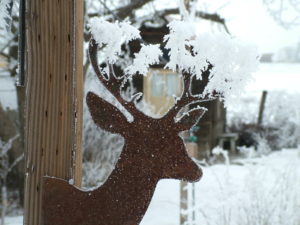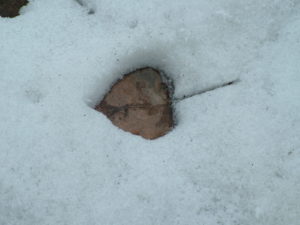About Hoarfrost
A bit over twelve years ago – early February of 2007 – we spent day after day here in our Central Washington Paradise wandering through that bone-chilling early morning fog, surrounded by the white ghosts of barbed wire, fence posts, grasses, weeds and trees. Each ghost comprised of delicate, fern-like shards of ice. At the time, no one seemed to remember it lasting so many days. This winter, we’ve had a few morning flashbacks.
Several homeys have shared their delight and questions. As Chief Meteorologist for the Reecer Creek Rod, Gun, Working Dog and Outdoor Think Tank Benevolent Association, I am duty-bound to share the following.
This is hoarfrost! Its name is from the Middle English “hore” or “hoor,” and the Anglo-Saxon “har” – words long used to describe something so old its hair is turning white. Truth be told, I’m a bit hoary myself.
Hoarfrost fills me with wonder and delights the kid in me with its magic. In a flash, I can find myself twenty feet up a cottonwood, in a ten-below-zero fog, along the South Platte River in eastern Colorado. So cold, I doubted I could draw my bow, even if a buck stood broadside forever. At last, as light seeped into the cottonwoods, glowing-white trees, shrubs and weeds filled every view. The breaking sun slowly lifted the fog. Fifty yards away, half a dozen rooster pheasants shimmered in a glowing hoary tree, as several does and a nice buck drifted across beneath them. That magical moment is permanently etched on my soul.
Frost is not just rain or dew that freezes into some form of ice; it occurs under specific conditions. The air must reach a point of saturation – holding all the water vapor it can hold – and its temperature must be below freezing. Then the air must cool enough more (generally by radiation of the ground’s heat to a clear sky) that it can no longer hold all its water vapor. Under calm conditions, the water will then change its state, and sublimate directly from vapor to solid.
In its solid state, water, like other minerals, has a crystal shape and structure. When water vapor sublimates onto a surface, as in the case of hoarfrost, it aligns with one or another of its infinite number of six-sided hexagonal crystalline structures, creating the delicate feathery patterns which decorate our windows in winter. At temperatures just below freezing we get frost across our windshields; at lower temperatures, we get the lacy, crystalline patterns that pain us to scrape away.
In calm, well‑below‑freezing conditions of saturated air, such as we experienced for a few days out of the last month or so, crystals will grow around dried weed stems and flowers, on metal fence structures, on tree limbs, and on almost any three‑dimensional surface. The crystals can reach a length of an inch or more, and may be shaped like long six-sided tubes, Siamese snowflakes, delicate Japanese fans, or whatever else they may choose.
While our hoarfrost was the result of sublimation of water vapor directly to ice, the other remarkable occurrence a couple homeys mentioned – on the ground – was from just the opposite process; ice sublimating directly to water vapor. This is how those leaves “sank” into the snow and ice, leaving perfect little leaf-shaped craters. The temperature stayed low, but during the first few days enough sunlight reached the ground to be absorbed by the dark brown leaves. Those leaves and their stems absorbed enough energy to trigger the change of state of the ice or snow under them to
water vapor. There was no liquid water at any point, hence, the absolutely perfectly shaped holes into which the leaves and their stems steadily sank an inch or more into the ice or snow.
Neither of these sublimation processes happen very often, even here in Paradise, so I took a couple dozen photos of several of the unique and amazing
patterns. These are the kinds of things Professor Joe Eagleman, my mentor, would examine for days when I was at the University of Kansas – the magic gifts of Nature which drove me to be a meteorologist and geographer.
Truth be told, I’m not the fan of the cold that I was then. Still, being lost in a glistening crown of hoarfrost, and the tale the crystals were telling, made me forget it was only eight or ten degrees out there.









